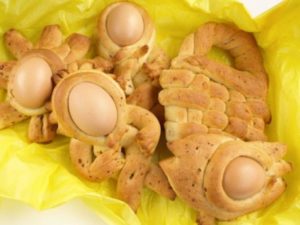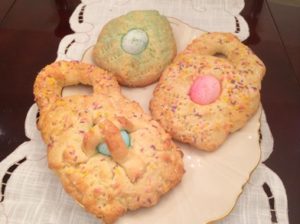Ci scusiamo. Al momento non è disponibile alcuna traduzione italiana per questa pagina.
Cuzzupa, a Traditional Easter Bread from Calabria
A classic Easter dessert in the region of Calabria, the cuzzupa is a lightly sweetened cake with eggs nestled into it. It is a tradition to make one cuzzupa for each member of the family, and the size of each cake may depend on age and “hierarchy” of the family member– the head of the family gets the biggest cake while the children get the smallest ones! Cuzzupe are a nice alternative to chocolate and other sweets that children receive at Easter time.

Cuzzupe can be made in many shapes. They’re molded by hand into braids, rings, hearts, nests, baskets, dolls, etc. A different shape may be used for each member of the family.
Traditionally, the number of eggs cradled in the cuzzupa had a meaning. Originally, much larger cuzzupe might be given, for example, by the parents of a bride-to-be to a prospective son-in-law, with nine eggs meaning that the engagement was approved; seven eggs meant that it was time to move onto marriage!
These cakes are very festive and every town and every family may have its own unique recipe. Some use eggs merely dyed a pale brown steeped in tea or onion skins; others are brightly colored. Some remain plain while others are showered with colored sprinkles.

Here’s one recipe:
6 c flour
4 t baking powder
pinch of salt
between 1/3 and 1/2 oz of crushed and cleaned anise seeds (* see note below)
4 t shortening (at room temperature)
1 c sugar
6 eggs (save 1 egg white to brush on cakes before baking)
3/4 c milk
confetti candy sprinkles (optional)
Color hard boiled eggs (amount is up to you, usually one per cake) a few days ahead of time.
Preheat oven to 350° – 375° depending on your oven. Grease flat cookie sheets or pans.
Crush anise seeds and set aside in dish.
On a bread board, sift together flour, baking powder, and salt (the same way you might make pasta). Mix in anise seeds. Mix in shortening with sugar and make a well in the middle. (This is the traditional Old Italian way, but you can also use a bowl to mix all ingredients.) Put in eggs (saving 1 egg white) and milk.
Gradually take flour from sides of the well and mix with eggs and milk. Don’t break the wall as all liquid will run out. When all is mixed, knead dough until a ball is formed with a smooth texture. (You may need to put a little flour on board or counter, so it will not stick, but not too much flour or the cakes will be too dry.) Then cut a chunk and leave the rest, covered, on the side of board or counter.
Roll out dough in a long, thin strip. Make the strip the thickness of a wooden spoon handle, not any thinner as the dough could break. If you twist 2 strips together to make a braid, make each a little thinner than your finger; they will swell as they bake. Put your colored eggs in the braid, nest, or dolls – whatever shape you decide to create. Be careful as you put them on a baking sheet so that they don’t break or crack. Roll small pieces of dough and then flatten out with the palm of your hand to criss-cross around the top of the egg, if desired, on dolls or nests. This helps keep the eggs more secure. If you make dolls, put a slit on feet and hands.
Beat saved egg white. With a pastry brush, brush egg white on all exposed parts of your cakes. While the egg white wash is still moist on the cakes, sprinkle with candy confetti (optional).
Bake in oven for about 15-25 minutes for smaller cakes, up to 45 minutes for larger cakes, depending on your oven. They should be lightly browned. Let them sit about 10 minutes to cool off before taking them off the cookie sheets. Be careful removing them from the pans to avoiding cracking the bread or the eggs. Store in an airtight container for about a week, if they don’t get eaten before that.
* This note is not usually necessary with store-bought brand anise seeds, but if you harvest your own from a garden: Use a cotton handkerchief to gather anise and twist hanky inside it. Then rub hard on the ball of anise. After rubbing it rolled up in between both hands, carefully sort out seeds from brown husks and, sometimes, small stones.
– some information adopted from L’Italo-Americano, April 2017